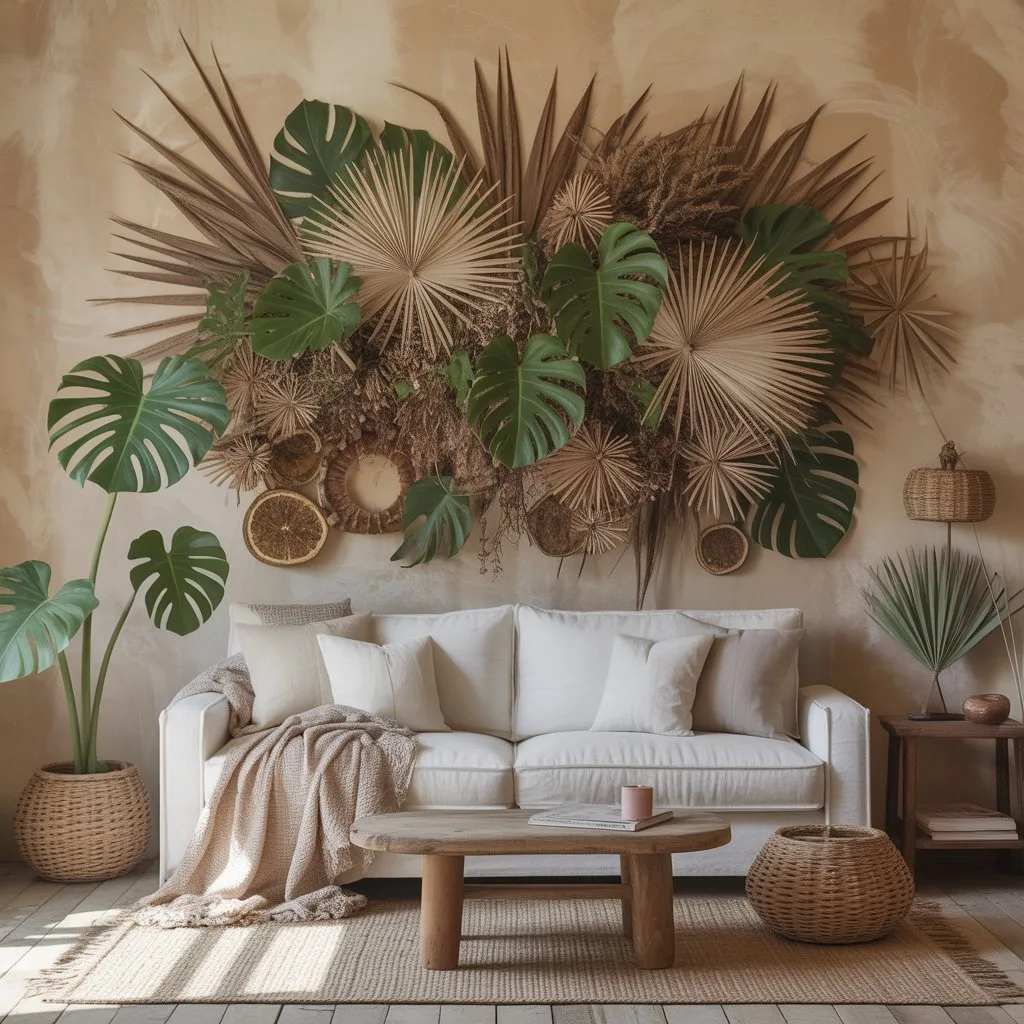Bringing nature indoors is one of the most satisfying ways to create a serene, eco-friendly living space. Using natural elements for wall décor allows you to combine beauty, texture, and sustainability while expressing personal style. From wooden accents to pressed flowers, stones, shells, and even recycled materials, natural wall decorations provide warmth, harmony, and a tactile connection to the environment.

Natural wall décor also offers a unique opportunity to showcase creativity. Each piece can be personalized, reflecting the colors, patterns, and textures that resonate with you. Unlike mass-produced items, handmade or thoughtfully sourced elements ensure your walls are both distinctive and environmentally conscious.
Choosing the Right Natural Materials
Selecting appropriate materials is key to creating stunning wall décor. Wood is a versatile option, suitable for everything from rustic panels to geometric art installations. Driftwood, reclaimed timber, or small branches add texture and warmth.
Pressed flowers and leaves offer delicate, botanical designs that bring color and elegance to any wall. They can be framed, mounted on canvas, or integrated into mixed-media displays. Consider seasonal or local flora to reflect the natural environment around your home.
Stones and pebbles create a tactile and grounding effect. Smooth river stones, pebbles, or even mineral slices can be arranged into mosaics, patterns, or wall sculptures. Shells and coral are ideal for coastal or tropical-themed interiors, bringing both texture and a sense of seaside tranquility.
For a truly eco-conscious approach, recycled natural materials, such as cork, bamboo, or reclaimed bark, can be incorporated. These materials not only reduce waste but also add unique textures and patterns that are difficult to replicate with synthetic products.
Preparing Materials for Wall Art
Proper preparation ensures durability and aesthetic appeal. Wood should be sanded smooth and treated with natural oils or wax to enhance color and protect against moisture. Driftwood can be cleaned and lightly varnished to preserve its natural form.
Pressed flowers and leaves must be thoroughly dried to prevent discoloration or decay. Sandwiching them between sheets of absorbent paper and using a heavy weight or flower press preserves their shape and color. Stones, pebbles, and shells should be cleaned, and any sharp edges smoothed to prevent damage or injury.
Designing Natural Wall Arrangements
Creating visually appealing arrangements begins with planning. Consider the size and scale of your wall and the focal points in the room. Grouping elements in clusters or patterns can create visual interest without overwhelming the space.
For wood décor, geometric patterns or asymmetrical arrangements add modern elegance, while stacked or layered pieces contribute a rustic, organic look. Pressed flowers and leaves can be arranged in frames, grids, or cascading vertical lines to create movement and flow.
Using stones and pebbles, consider mosaics, framed patterns, or three-dimensional installations that project slightly from the wall. Mixing natural elements, such as wood, stones, and shells, can create a harmonious and layered design that combines texture, color, and depth.
Hanging and Mounting Techniques
Selecting the right mounting method is essential for stability and safety. For lighter elements, adhesive strips, natural twine, or hook-and-loop fasteners may suffice. Heavier pieces, like driftwood panels or stone mosaics, require wall anchors, nails, or screws.
When arranging multiple pieces, laying them out on the floor first helps visualize the final composition. Spacing, alignment, and proportion are crucial to maintain balance and aesthetic appeal. For three-dimensional pieces, ensure they are mounted securely to avoid movement or damage.
Incorporating Natural Elements into Themed Walls
Natural wall décor can be adapted to various themes. Botanical walls, featuring leaves, flowers, and pressed plants, create a calming, garden-inspired atmosphere. Coastal walls use shells, coral, and driftwood for a breezy, beach-inspired feel. Rustic or woodland-themed walls utilize raw wood, bark, and stones to evoke forest textures.
Eco-friendly or minimalist interiors benefit from simple, clean lines using bamboo panels, cork tiles, or singular statement pieces of natural materials. Layering textures and subtle variations in color adds depth without overwhelming minimalist spaces.
Seasonal and Rotational Displays
Natural wall décor allows for seasonal creativity. Spring can bring fresh greenery, wildflowers, or flowering branches; autumn can introduce dried leaves, acorns, or pinecones. Rotating natural elements with the seasons ensures your décor remains fresh, dynamic, and relevant to your living space.
This approach also allows experimentation with color, texture, and arrangement, providing an ongoing creative outlet while keeping your environment connected to nature’s cycles.
DIY Projects Using Natural Materials
Numerous DIY projects can enhance walls with natural elements. Pressed flower collages in glass frames create delicate, colorful focal points. Driftwood mobiles or branch installations can be suspended horizontally or vertically for dynamic, sculptural effects.
Stone mosaics can be created on panels or canvases, forming patterns, geometric shapes, or abstract designs. Shells can be arranged into artistic compositions, mounted on canvas, or strung into wall hangings. Combining these elements offers opportunities for personalized art pieces that reflect creativity, sustainability, and connection to nature.
Maintenance and Longevity
Proper care ensures your natural wall décor remains attractive and durable. Dust wooden elements and frames regularly with a soft cloth. Avoid direct exposure to moisture, which can warp wood or degrade pressed plants.
Pressed flowers should be kept away from direct sunlight to prevent fading. Stones and shells may benefit from occasional gentle cleaning with a damp cloth to remove dust without damaging surfaces. Using natural oils or protective coatings on wood and bark extends the lifespan of your pieces.
Educational and Creative Benefits
Creating and displaying natural wall décor fosters learning and creativity. Exploring different textures, colors, and patterns enhances design skills and develops an understanding of natural materials. Children and adults alike can gain hands-on experience in crafting, plant identification, and sustainable design.
The process of curating and arranging natural elements on walls also promotes mindfulness and stress reduction. Observing and interacting with tactile, organic materials creates a calming and engaging experience, enhancing the overall ambiance of the home.
Expanding Design Possibilities
Once comfortable with basic wall décor, experimenting with mixed-media compositions opens new possibilities. Combining natural elements with fabric, clay, or recycled materials adds depth and complexity. Layered textures, varying scales, and contrasting natural tones create visually striking and innovative displays.
Personalized arrangements, incorporating family memories, travel souvenirs, or locally sourced items, ensure your wall décor is not only beautiful but also meaningful and unique. Each piece tells a story while contributing to an eco-conscious, stylish environment.
Harmonizing with Interior Spaces
Natural wall décor complements a wide range of interior styles. Scandinavian or minimalist spaces benefit from clean lines and muted textures of wood, cork, or bamboo. Bohemian or eclectic interiors can incorporate a mix of colorful pressed flowers, stones, shells, and natural fibers.
Rustic, farmhouse, or woodland-inspired homes embrace the authenticity of raw wood, bark, and organic textures. By considering the surrounding color palette, furniture, and lighting, natural wall elements can seamlessly enhance any room, creating cohesion and harmony.
Combining Function and Aesthetic
Natural elements can serve dual purposes, offering both decoration and functionality. Wooden panels can act as acoustic dampeners, pressed plants can be integrated into magnetic boards for notes, and shells or stones can be repurposed as hooks or holders.
This functional approach maximizes utility while maintaining eco-friendly design principles. Each piece of décor becomes a part of the living environment, blending artistry with practicality.
Creating wall décor using natural elements is a rewarding way to bring nature indoors, enhance living spaces, and engage in sustainable, creative projects. From wooden installations to pressed flowers, stones, shells, and recycled materials, the possibilities are vast and adaptable to any style or space.
By thoughtfully selecting, preparing, and arranging natural elements, you can craft unique, eco-conscious wall décor that combines beauty, texture, and personal expression. Exploring seasonal changes, mixed-media designs, and functional applications keeps your interior environment dynamic and inspiring.
Engaging with natural materials for wall décor fosters creativity, mindfulness, and a deeper connection with the environment. Incorporating sustainable design practices into your home not only enhances aesthetics but also supports an eco-conscious lifestyle. Crafting and curating these elements provides ongoing opportunities for self-expression and environmental appreciation.
Lucas Hartman is a DIY enthusiast and sustainability advocate focused on natural crafts and eco-friendly home décor. With a background in arts and design, Lucas creates tutorials that help families and hobbyists transform everyday recycled or organic materials into beautiful, functional projects.
